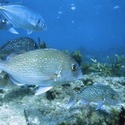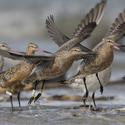New Zealand separated from Gondwana around 65 million years ago. Due to the geographical isolation and a lack of ground-dwelling predators, our birds evolved unique characteristics. Flight was not required to escape predators, so birds such as the kiwi, takahē and (now extinct) moa adapted to these conditions by developing a large body size and loss of flight.
Adaptation is an evolutionary process
Adaptation is an evolutionary process whereby an organism becomes increasingly well suited to living in a particular habitat. These are changes that occur over many, many generations. It is definitely not a quick process!
Adaptations occur through natural selection. Organisms that have features better suited to their habitat will survive over successive generations, while those that are not well suited to the environment will not survive. Surviving species will then reproduce, producing more individuals within the population that have the same, favourable features for survival. Over many generations, more and more of the individuals within the species will have the favoured features until eventually all individuals will have them. Charles Darwin originally documented natural selection as a function of evolution in 1854 in his book On the Origin of Species.
Adaptations can result in the gain of a new or a modified feature that results in an advantage in the current environment, for example, a specialised beak. Adaptations can also result in the loss of a feature that no longer has a function in the current environment, for example, the loss of wing function when there is no need to fly. The takahē adapted to survive in some of Aotearao New Zealand's harshest landscapes.
Adaptations are many and varied, but they are generally grouped into 3 main categories: structural, behavioural and physiological.
Structural adaptations
Structural (or morphological) adaptations are changes to the physical features of the organism. These include things you can see, like its shape or body covering, as well as its internal organisation. These can occur in populations over many generations.
Here are a few of the ways New Zealand birds have adapted their physical features to suit a particular habitat:
- The kiwi is the only bird in the world to have nostrils at the end of its beak. This enables it to search for food by probing its long beak into the earth in search of invertebrates.
- Kiwi have fine whiskers at the base of their beak to aid them in navigating obstacles in dim light as they have poor eyesight.
- The kererū has the widest gape of any New Zealand forest bird. This enables it to swallow, digest and disperse the large fruit and seeds of the karaka, miro and tawa trees.
- The tūī has a long, curved beak and a fine brush-tipped tongue that enables it to extract nectar from forest tree flowers.
- Takahē and kiwi have vestigial wings. After many years of not requiring the use of flight, they evolved a larger body size and lost the ability to fly.
- Kiwi plumage blends in with forest undergrowth to allow them protection from predators through camouflage.
Behavioural adaptations
Behavioural adaptations are learned or inherited behaviours that help organisms to survive. These can occur in populations within one or a few generations.
Here are a few of the ways that New Zealand birds have adapted their behaviour to suit a particular habitat:
- The kiwi is a nocturnal bird. This behaviour helps to reduce its risk of predation and competition for food during daylight.
- Kākāpō chicks feed almost entirely on the seeds of the rimu tree. The mating cycle of the kākāpō is tightly linked with the fruiting of the rimu tree, and in abundant fruiting years, a greater number of kākāpō chicks are often born.
Physiological adaptations
Physiological adaptations relate to how an organism’s metabolism works. These adaptations enable the organism to regulate their bodily functions, such as breathing and temperature, and perform special functions like excreting chemicals as a defence mechanism. These can occur in populations over many generations.
Kererū are one of few birds to produce crop milk, a protein-rich milky secretion from the walls of the parents' crops. When mixed with fruit pulp, this sustains their chicks in the early stages of life.
Native birds in a changing environment
Many New Zealand birds are poorly adapted to an environment that has changed greatly over time.
Their environment has changed enormously over the past 1,000 years – primarily due to colonisation by human settlers. Humans introduced mammalian predators, cleared native bush, resulting in a loss of natural habitat for birds, and hunted birds as a food source.
Conservation efforts are required to protect our native bird species that are currently endangered.
Related content
We have re-purposed the popular Building Science Concepts Book 3: Birds: Structure, Function, and Adaptation with an article and interactive linking this great resource with Hub content.
Bird adaptations and identification has information to help hone your identification skills. Kei ngā urutaunga me te tautohunga manu he mōhiohio hei āwhina i a koe ki te whakakoi i ō pūkenga tautohunga.
The Connected article Life in Aotearoa New Zealand looks at what made our wildlife so unique and introduces the science concepts evolution and adaptation.
Investigate how New Zealand came to have such unique ecosystems – one dominated by birds and explore how our unique ecosystem has changed over the years in Our changing ecosystems.Find out more about takahē adaptations in the article The takahē’s ecological niche.
Read about the conservation efforts to increase kākā numbers, including research on modifying their behaviour to better suit an urban environment.
Activity idea
Classifying bird adaptations uses cards and literacy techniques to explore key science concepts.










